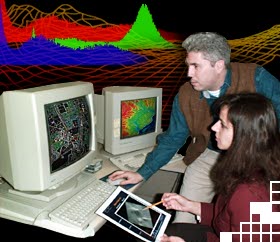
| Table of Contents |
| 1. Introduction 2. Sensors 3. Microwaves |
4. Image Analysis |
| 5. Applications |
Fundamentals of Remote Sensing
4.9 Endnotes
You have just completed Chapter 4 - Image Interpretation and Analysis. You can continue to Chapter 5 - Applications or first browse the CCRS Web site for other articles related to Image Interpretation and Analysis.
By browsing the "Images of Canada", you can learn in detail about the visual elements of interpretation and test yourself with a variety of remote sensing questions and answers.
We have a downloadable tutorial and exercise on the topic of digital images and digital analysis techniques that makes a good start into this field.
See how the Intensity, Hue and Saturation (IHS) transformation, as applied to 3-D images are used to help visualize terrain relief. As well, an IHS transformation can also be used to exploit the synergy of two different image data sets; in the case shown here, to study the hydrogeology of an area. Image fusion of data from different sensors is well demonstrated in an image of Canada's Capital - Ottawa.
Image compression is important for storage and transmission of large images. One compression technique developed at CCRS uses multiscale methods to compress images and reduce file size.
There are many other image manipulation / interpretation techniques demonstrated on the CCRS Web site. You may also want to check our Remote Sensing Glossary for terms in the ![]() "techniques" category.
"techniques" category.
| Updated2002-08-21 | Important Notices |